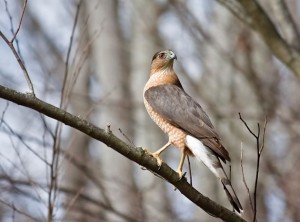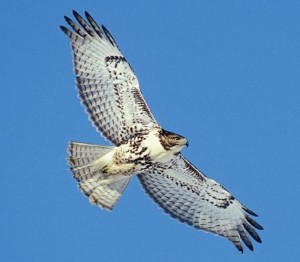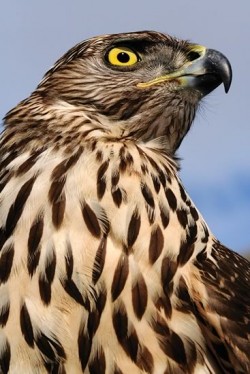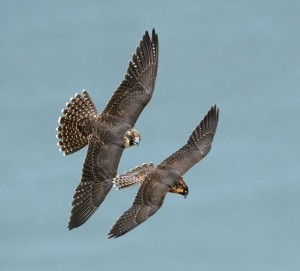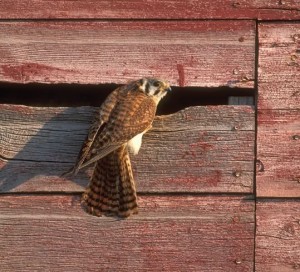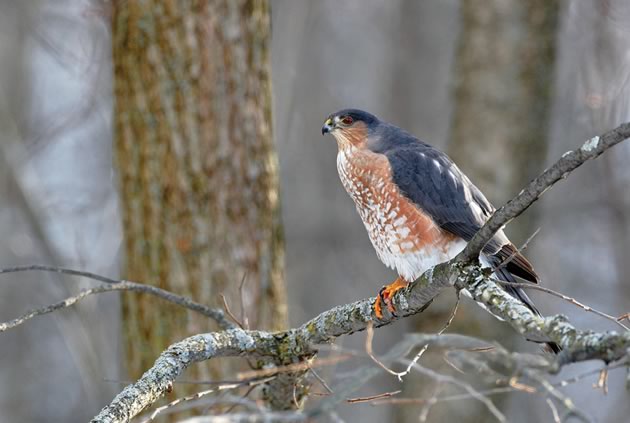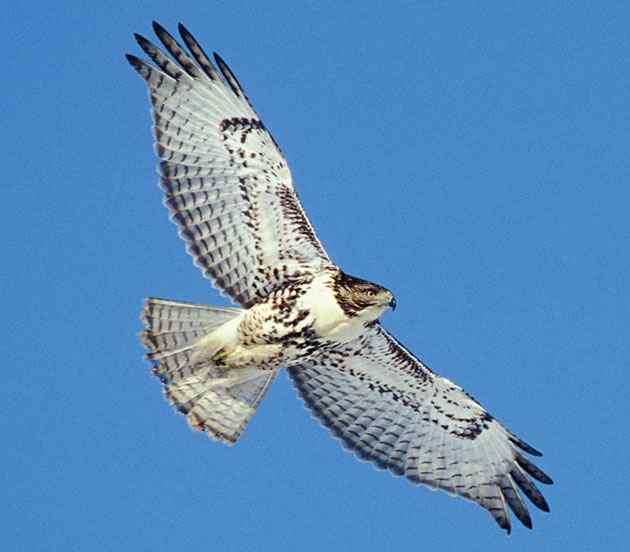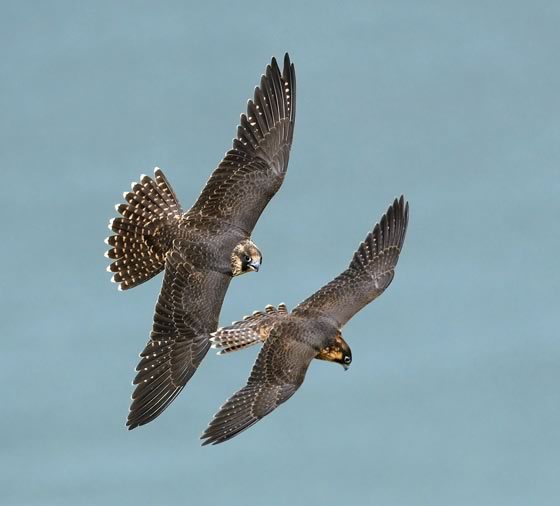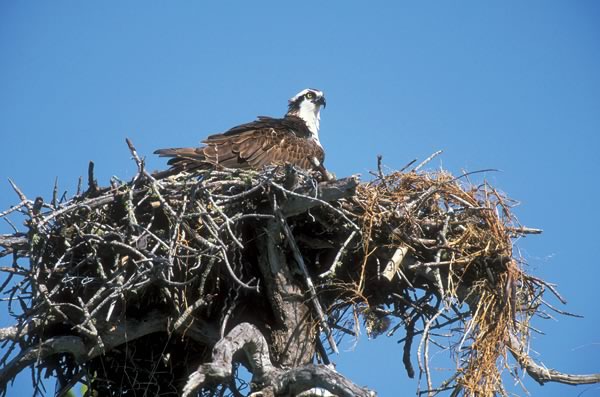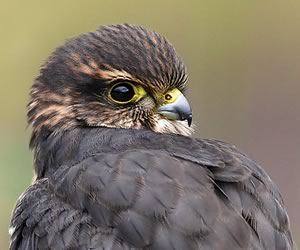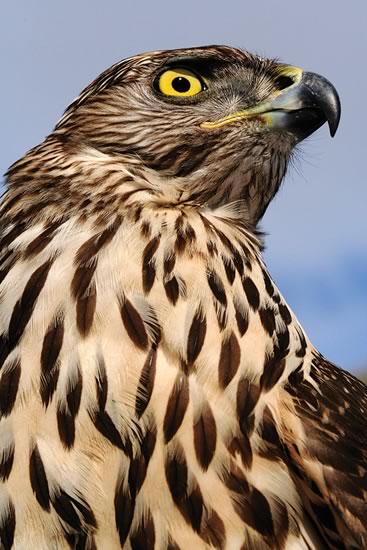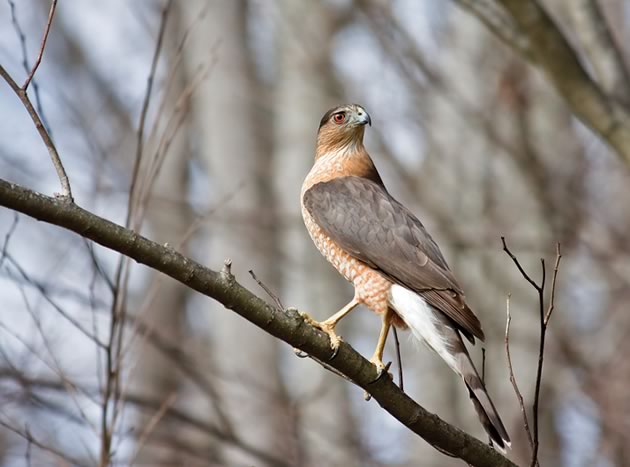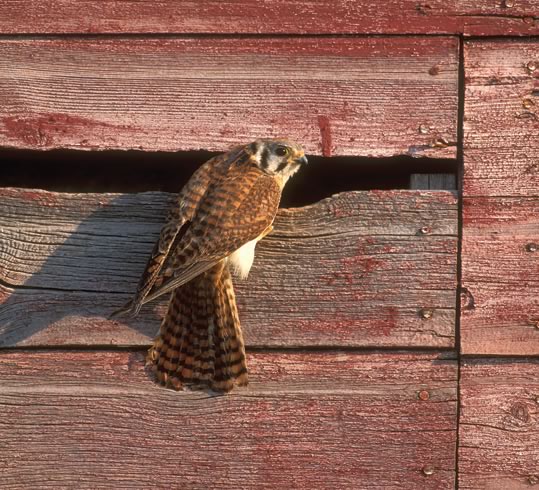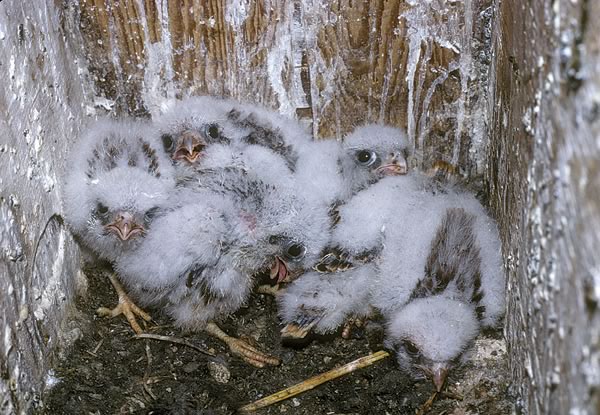Soaring Skyward
Once gleefully slaughtered as “bloodthirsty villains,” hawks have reclaimed their status as lords of the sky.
A century ago hawks flew skies that were often peppered with lead shot. Like aircraft over enemy territory the hawks’ migratory journeys were subject to withering fusillades from the ground. Once settled in their breeding territories they were blasted as they sat on their nests or as they described their classic soaring spirals overhead. It was a time when animals were judged in moral terms: some were good, others bad. Because some hawks included poultry in their diets, they were cast as “bloodthirsty villains” and “audacious murderers.”
Three hawk species that make their home here in the hills – the sharp-shinned, the Cooper’s hawk and the northern goshawk – were largely responsible for the infamy that tarnished all their kind. These hawks are known to science as accipiters, or commonly as “bird hawks.” With short wings and long tails they are designed for the quick twists and turns necessary to out manoeuvre and catch other birds. Their scimitar-shaped talons are needle sharp – ideal for holding fast to struggling prey.
In 1925, author William Atherton Dupuy captured the prevailing sentiment about the birds in Our Bird Friends and Foes: “The three villain hawks that deserve death are the Cooper [sic] hawk, the goshawk and the sharp-shinned hawk. These the farmer should shoot on sight.”
Shoot on sight the farmers did. One in southwestern Ontario reportedly sat in his front yard during a particularly strong migratory event and shot fifty-six sharp-shinned hawks without rising from his chair. But farmers were not the only ones engaged in the slaughter. Anyone with a gun and an urge to pull the trigger cheerfully participated.
Nor was hawks’ appetite for fresh chicken the only reason the shooters used to justify their actions. Jack Miner, celebrated as one of the world’s foremost conservationists in the early decades of the twentieth century, condemned Cooper’s hawks and sharp-shinned hawks because they ate the songbirds at his Kingsville, Ontario bird sanctuary. In The Story of Wild Goose Jack by James M. Linton and Calvin W. Moore, Miner is quoted in reference to his beloved cardinals falling prey to hawks: “I didn’t feed these cardinals all winter to feed a bunch of bird murderers. We kill murderers of [the] human family, why not shoot the murderers of the valuable weed- and insect-eating bird family?”
Miner distinguished between the “cannibal hawks,” as he called the accipiters, and raptors, such as the red-tailed hawks that prefers a diet of rodents. Although Miner had no desire to punish the latter, many of his contemporaries, unable or unwilling to distinguish between species, targetted all of them. So many red-tailed hawks were being shot that Arthur Cleveland Bent, in his Life Histories of North American Birds of Prey (1937), seemed resigned to their extermination: “It will be a sad day indeed when we shall no longer see the great red-tail sailing over the treetops on its broad expanse of wing and ruddy tail, or soaring upward in majestic circles until lost to sight in the ethereal blue, or a mere speck against the clouds.”
Mercifully, that “sad day” has not arrived. Hawks of several species still grace the skies of Headwaters, and throughout Ontario they are generally doing well. The second Atlas of the Breeding Birds of Ontario, undertaken from 2001 to 2005, documents dramatic increases in the numbers of some hawks since the first atlas project in the 1980s. Other species have maintained stable numbers. Only one species, the American kestrel, registered a significant decline.
Today, with bad news about wildlife seemingly the norm, the relatively good health of our hawk populations offers hope. Attitudes have changed over the years and hawks are more likely to be admired than loathed. Most people realize that a healthy predator population is reflective of a healthy environment.
If attitudinal change has helped hawks, so too has legislation based on good science. The banning of DDT by Canadian and American governments, in 1969 and 1972 respectively, arrested the descent into oblivion of a number of raptor species. DDT had had a particularly dire effect on osprey and peregrine falcons. Its notorious alchemy weakened the shells of their eggs, causing them to collapse when sat on.
After DDT was banned, conservation science also stepped in to lend a hand. Peregrine young were “hacked,” a term used to describe the rearing of peregrine young by biologists who then release them into the wild. As for ospreys, artificial nesting platforms beside lakes and coastlines were erected to support their immense nests. These the ospreys use readily. A pair has nested successfully at Island Lake Conservation Area since 2004 on a platform placed on a hydro pole. According to Bill Lidster, a senior superintendent for Credit Valley Conservation, the fish-eating ospreys feast on Island Lake’s bounty of pike, perch and crappie.
The reforestation of marginal farmland and the maturing of forests have also helped hawks. However, the hawks themselves deserve considerable credit for their own recovery, because, as it turns out, they possess some of the finest of bird brains. Hawks were perched at the top of the avian bell curve in a study conducted by McGill University Professor Louis Lefebvre that ranked the intelligence of various birds by their ability to solve problems and to adapt to new situations.
Hawks’ intelligence has also been documented in their hunting behaviour. In 2007, John T. Neville of Newfoundland’s department of environment watched as his beagle chased a snowshoe hare. A goshawk watched as well, and strategically positioned itself to launch attacks on the hare when it was flushed by the beagle. Eventually the goshawk carried off the prize (no doubt to the chagrin of the dog). Harriers, open-country hawks found throughout this area, have been observed hunting along the margins of grass fires, picking off small mammals fleeing the blaze.
Hawks have even been known to defer gratification in anticipation of richer rewards. Lyle Friessan, a songbird biologist with the Canadian Wildlife Service, discovered the goshawks’ ability to plan ahead when he monitored wood thrush nests near Waterloo. Friessan placed cameras at the thrush nests to record predation of eggs and young. In 2007, goshawks raided all six wood thrush nests at one study site. This was not particularly surprising – goshawks are consummate bird predators. What did surprise Friessan was the strategy the goshawks employed:
“The goshawks appeared to wait until the wood thrush fledglings reached a certain size before snatching them. A goshawk visited one nest that contained only eggs, left without taking any of them, returned when the fledglings were about two days old and again left without taking anything, and returned when the young were nine days old and hauled all of them away.”
The goshawks, like livestock managers, were presumably waiting for the young thrush to “fatten” up before the slaughter. Incidentally, Friessan had no inkling before setting up the cameras that goshawks were even in the neighbourhood. For such large hawks (about the size of red-tails) goshawks can be very secretive. I wasn’t able to find them in my breeding bird atlas territory in Caledon until I played a tape of a goshawk call. Almost instantly, a pair of goshawks responded with their aggressive kek! kek! kek!
Further testimony to hawk intelligence is the extraordinary adaptability of some species. Just twenty-five years ago, Cooper’s hawks were a species of concern. Human activity had reduced their numbers drastically, and a population rebound was deemed highly unlikely because the forested habitat they require was largely gone.
What researchers didn’t consider was the Cooper’s hawks’ ability to assess their options and change their behaviour. The hawks decided to move to the city. Towns and cities provide ample food for hungry hawks and mature urban neighbourhoods offer large trees for nesting. Other avian urbanites introduced from Europe – starlings, house sparrows and pigeons – now have new world predators to worry about.
Bob Curry, who has the enviable job of searching for birds for Credit Valley Conservation’s natural areas inventory, also thinks the Cooper’s hawks have benefitted from the growth in mourning dove populations over the last few decades. Cooper’s hawks and several other raptors once feasted on the formerly abundant passenger pigeons. Mass killing and habitat destruction drove the pigeons to extinction a hundred years ago, an ecological catastrophe that deprived a host of predators, including hawks, of their meal tickets. Mourning doves may now be making up for some of the loss. Local residents who maintain their own winter bird-feeding stations may have witnessed evidence of hawk kills when they’ve found dove feathers littering the snow near their feeders.
Small falcons called merlins have also experienced a population explosion over the last two decades as they sweep into more urban southern Ontario from their boreal forest stronghold. Cities have proven no impediment for these swift aerial predators. Ottawa now hosts several pairs of merlins. Only a few were found in the Headwaters during the second breeding bird atlas project (they probably nested at Luther Lake), but if trends continue we may soon have the opportunity to get to know these sleek little falcons better.
Peregrines have also adapted to city life. To peregrine eyes, tall buildings differ little from the cliffs where they nest in the wild, and pigeons and gulls offer an abundant source of food. Toronto, Hamilton and London now boast nesting peregrines. No peregrines are currently known to nest in Headwaters country, but if the peregrines’ population continues to grow perhaps some blessed future spring will find these magnificent birds nesting on the Niagara Escarpment at Mono Cliffs – near the ravens that have recently reclaimed their ancestral real estate there.
The typical hawks of expansive wing and tail, usually observed wheeling high overhead on invisible thermals of rising warm air, are known as buteos. Four species of buteos are found in our area; of them, the red-tailed hawk is the most familiar.
Despite unholy efforts to eradicate them in years past, red-tails are our most abundant hawks. The large hawks seen roosting by summer roadsides are most often red-tails. (Even those without the characteristic ruddy tails are likely juvenile red-tails; the red colouring comes with maturity.) In the winter, red-tailed hawks share fence posts and telephone poles with rough-legged hawks, also members of the buteo clan. These lovely black and white raptors migrate from the Arctic into southern Ontario in the fall and stay until early spring.
Before forests were cleared in southern Ontario the red-tailed hawk was eclipsed in numbers by its slightly smaller relative, the red-shouldered hawk. Lovers of the forest primeval, the red-shoulders had plenty of living space at that time. Today in our hills, they are found only in areas of continuous forest cover, such as the Niagara Escarpment and the Oak Ridges Moraine. In such haunts these lovely hawks, with breasts barred robin-orange, feed on a wide variety of prey, often plucking frogs and toads from woodland pools.
Another local buteo is the broad-winged hawk. It also has an affinity for forests and its range in southern Ontario, illustrated in the breeding bird atlas, clearly delineates the Niagara Escarpment and the Oak Ridges Moraine. Broad-winged hawks have the same form as red-tailed hawks but are noticeably smaller. Their voice is also less impressive. Decidedly un-hawk like, it has the shrill quality of a tea kettle coming to boil. Think of the call of a cedar waxwing amplified.
However, if the call of the broad-winged hawks is not impressive, their habit of travelling in flocks of hundreds, even thousands, during their fall migration certainly is. These aggregations of hawks, called “kettles,” swirl high overhead on thermals, leisurely moving towards the south. Birders very much anticipate the spectacle of these mass migrations. In years past, the hawk shooters did as well. Like buffalo hunters they gloried in an orgy of easy slaughter. Arthur Cleveland Bent related mass killings of broad-winged hawks that occurred in two Minnesota towns in 1925. An estimated 4,000 were killed by the townspeople in a single day.
Though spectacular in migration, broad-winged hawks can be difficult to see during the breeding season, when they usually conduct their affairs among the shelter of trees. However, at times they do soar like red-tailed hawks. On sunny days I’ve watched broad-winged hawks circle high above the trees at Forks of the Credit Provincial Park
Harriers, formerly known as marsh hawks, are drawn to the extensive old fields in our area, especially those that have wetlands nearby. Richard Procter recounts watching a harrier hunting over the fields of his farm near Mansfield. “It glides low on breezy days,” he says, “just skimming a few feet above the tops of the tall grass, occasionally wheeling about to pounce on something. Quite impressive as it cruises along like a dragonfly.”
I like Richard’s description. There is nothing direct about harrier flight, nor do they soar in neat circles. Rather they “bob” about in the wind and are prone to sudden changes in direction – like a dragonfly.
My most memorable experience with a harrier was at Cataract during the first breeding bird atlas project. Harriers are ground nesters and as I hiked through a meadow I must have come uncomfortably close to a nest. A male harrier (the males sport a slate-grey topside to the females’ brown) launched itself towards me uttering a scolding kekekeke! As he hovered overhead I could see that he held something in his talons. Then, like a bombardier, he released his payload. A plump meadow vole fell to the ground at my feet.
The only hawk species in Ontario known to have experienced a significant decrease in recent years is the American kestrel. However, these robin-sized falcons are still common in the Headwaters region and throughout southern Ontario. As an open-country species, their decline may simply be due to the conversion of their favoured old-field habitats to woodland.
Kestrel numbers may be limited as well by nest site availability. Kestrels are our only cavity-nesting hawks, relying on holes excavated by flickers and pileated woodpeckers. Kestrels frequently perch on telephone wires or hover facing into the wind as they scan the ground for grasshoppers and other large insects. They also feed on meadow voles and it has been suggested that they use their ability to see ultraviolet light to locate the urine trails of these small rodents. (Meadow vole urine glows purple in the ultraviolet!) Because they live along our roads and highways, kestrels make great subjects for close observation. They are truly beautiful. The males in particular are gorgeous, with blue-grey wings and rufous backs and tails.
I recently had the opportunity to visit the Open Sky Raptor Foundation Centre in Grimsby where sick and injured hawks are treated and rehabilitated. The hawks arrive at the foundation suffering from a variety of complaints – some ill from natural causes, but others the victims of poisoning, electrocution, collisions with vehicles and impacts with windows. A few arrive as gun-shot victims, echoing the calamity of yesteryear.
I stood with Carol Riccinto, the foundation’s director, in a spacious shelter housing fourteen red-tailed hawks among the 120 or so raptors she currently cares for. These red-tails, nearing release, flew strongly about the enclosure, demonstrating their readiness to resume life in the wild. When that day comes, Riccinto will once again bask in the glow that comes from a job well done. “I respect them so much” she says “and I love to see them go. When the hawks make a bee-line away from me without so much as a glance back, I know I’ve done something good.”
Today, most would agree with Carol Riccinto that hawks are worthy of respect and admiration. A remarkable sea change in attitude has occurred. One hundred years ago the flight path of our hawks dipped perilously low. In recent decades it has soared skyward, thanks to caring people and to the adaptability and intelligence of the hawks themselves.

